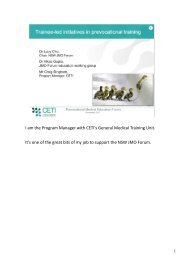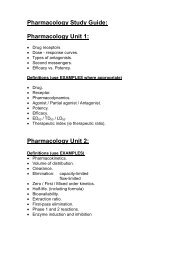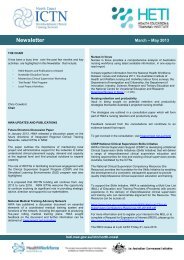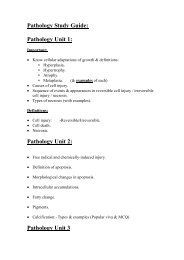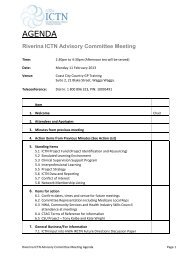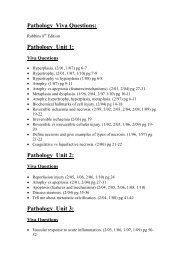Network principles for prevocational medical training - HETI
Network principles for prevocational medical training - HETI
Network principles for prevocational medical training - HETI
Create successful ePaper yourself
Turn your PDF publications into a flip-book with our unique Google optimized e-Paper software.
<strong>HETI</strong> NETWORK PRINCIPLES<br />
Goal 1- continued.. Goal 2 – continued… Goal 3 – continued…<br />
1.2.2 The term supervisor provides<br />
an orientation to all junior <strong>medical</strong><br />
officers at the commencement of<br />
each term.<br />
1.2.3 At the commencement of<br />
each term, the hospital ensures<br />
that the <strong>prevocational</strong> trainee has<br />
the appropriate knowledge and<br />
skills <strong>for</strong> safe practice <strong>for</strong> the term<br />
1.2.4 The Hospital ensures that<br />
<strong>prevocational</strong> trainee’s receive an<br />
effective handover at the commencement<br />
of each term<br />
1.2.5 The hospital evaluates orientation<br />
to each term and utilises the<br />
in<strong>for</strong>mation to improve the quality<br />
of orientation.<br />
1.3 Supervision<br />
The hospital provides<br />
<strong>prevocational</strong> trainees with<br />
adequate and appropriate<br />
supervision.<br />
1.3.1 The hospital provides adequate<br />
numbers of appropriately<br />
qualified <strong>medical</strong> staff to supervise<br />
<strong>prevocational</strong> trainees in all work<br />
situations<br />
1.3.2 The hospital ensures that<br />
there is effective clinical supervision<br />
of all <strong>prevocational</strong> trainees<br />
during normal hours<br />
1.3.3 The hospital ensures that<br />
there is effective clinical supervision<br />
of all <strong>prevocational</strong> trainees<br />
outside normal hours<br />
2.2.2 The balance and mix of terms<br />
(glossary) allocated to each <strong>prevocational</strong><br />
trainee provides a two-year<br />
program of general <strong>training</strong>.<br />
2.2.3 The hospital monitors and<br />
evaluates <strong>training</strong> and workload in and<br />
across all terms<br />
2.3 Formal Education Program<br />
The hospital provides<br />
<strong>prevocational</strong> trainees with an<br />
effective education program<br />
2.3.1 The hospital provides a <strong>for</strong>mal<br />
and structured education program<br />
2.3.2 The hospital evaluates the adequacy<br />
and effectiveness of the <strong>for</strong>mal<br />
education program and utilises the<br />
in<strong>for</strong>mation to improve the program<br />
2.4 Clinicians as Teachers<br />
The hospital provides effective<br />
clinical teaching and trains and<br />
evaluates clinicians in their role<br />
as teachers<br />
2.4.1 The hospital ensures that all clinicians<br />
who are responsible <strong>for</strong> teaching<br />
are aware of their responsibilities.<br />
2.4.2 The hospital has processes to<br />
develop the teaching skills of clinicians<br />
who provide <strong>training</strong> to <strong>prevocational</strong><br />
trainees<br />
3.2 Prevocational Trainees with<br />
Special Needs<br />
The hospital identifies and<br />
supports <strong>prevocational</strong> trainees<br />
with special needs<br />
3.2.1 The hospital is effective in the<br />
early identification of <strong>prevocational</strong><br />
trainees with special needs.<br />
3.2.2 The hospital provides structured<br />
support <strong>for</strong> <strong>prevocational</strong> trainees with<br />
special needs coordinated at term,<br />
hospital and network level as appropriate.<br />
3.2.3 The hospital and network routinely<br />
monitors and evaluates the identification<br />
and support <strong>for</strong> <strong>prevocational</strong><br />
trainees with special needs and uses<br />
the in<strong>for</strong>mation gained effectively<br />
3.3 Safe Practice<br />
The hospital provides an<br />
environment that supports the<br />
safety of <strong>prevocational</strong> trainees<br />
3.3.1 The hospital provides duty rosters<br />
that balance the service needs of<br />
the hospital with safe working hours<br />
<strong>for</strong> <strong>prevocational</strong> trainees.<br />
3.3.2 The hospital complies with its<br />
occupational health and safety obligations<br />
to <strong>prevocational</strong> trainees.<br />
3.3.3 The hospital evaluates the safety<br />
of working conditions of <strong>prevocational</strong><br />
trainees and uses the in<strong>for</strong>mation to<br />
improve safety<br />
57



